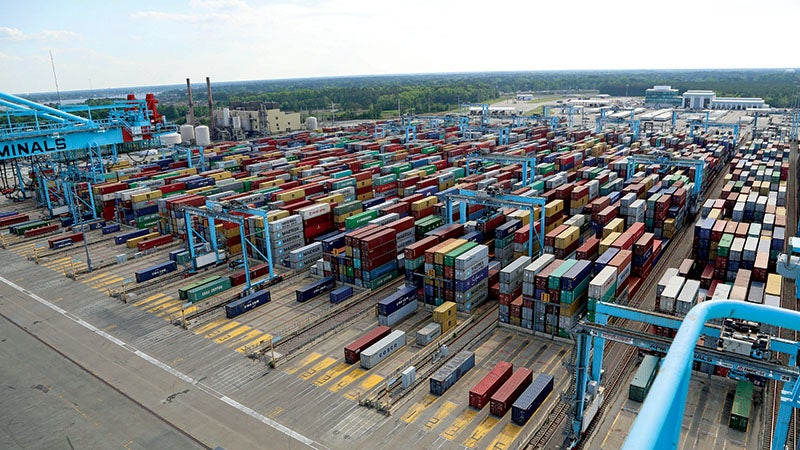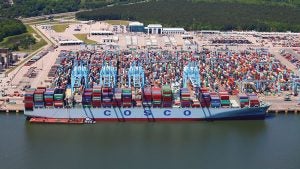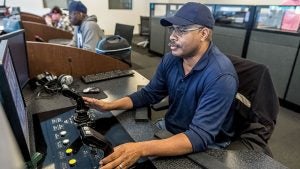A dance of steel and rubber
Published 1:18 am Wednesday, July 19, 2017

- Semi-autonomous stacking cranes sort the thousands of containers that are loaded onto and unloaded from ships docked at the Virginia International Gateway port facility near the border of Portsmouth and Suffolk. (Virginia Port Authority photo)
A huge wall of windows in a fourth-floor conference room at the Virginia International Gateway facility off Route 164 near the border of Portsmouth and Suffolk overlooks a bustle of activity in the distance.
From this height and this distance from the wharf, tractor trailers look like toys lined up and waiting for a precocious preschooler to load them with little orange, green, gray, white and blue boxes. Tucked away and almost invisible behind towering stacks of those containers is the largest ship ever to grace the waters of Hampton Roads, home of one of the largest natural harbors in the world.
The OOCL France has a capacity of 13,208 TEUs — the shipping industry’s standard unit of volume, which measures 20-foot units. It’s about 1,200 feet long and 158 feet wide. It is the second record-breaking cargo ship to dock at VIG in less than a month.
Virginia Port Authority spokesman Joe Harris puts all those numbers into perspective as he watches a veritable ballet of activity taking place on the docks.

The Cosco Development became the biggest ship ever to visit a Virginia port on May 8. Within three weeks, another ship, the OOCL France, had taken that title. (Virginia Port Authority photo)
“What you’re seeing here is a significant portion of the Virginia economy,” he says. “What you’re seeing here is jobs moving Virginia’s economy.”
During the recent visit in which the OOCL was loading and offloading containers onto the docks at the Portsmouth facility, another, smaller ship was docked along the same wharf, with 9,000 TEUs aboard.
The parking lot outside VIG was full of vehicles, and the building — much like the cargo-handling area outside — was buzzing with activity.
With eight massive cranes from China lining the docks, the port facility can handle about 2,500 lifts — either loading or unloading a container — per day. That works out to about half a million lifts per year, and a massive expansion project now under way and expected to be complete in 2020 will grow the total capacity at VIG alone to about one million lifts a year.
The scale of the operation is hard for the eye to compass. The huge cranes that can be seen from the highway are just the beginning of it all. Each crane is 275 feet tall at its highest point and weighs 65 tons. The cranes lift containers from and onto the docked ships.
When those containers are loaded into rectangular areas on the ground below — looking for all the world like blocks stacked up in a real-world game of Tetris — an intricate dance of steel and rubber commences, and it’s all controlled remotely from inside the building, where port workers tweak joysticks to move the containers from one stack to another and then onto waiting tractor trailers.
A complex computer program helps remote operators of the automatic stacking cranes sort through the eight rows of containers that can be lined up 50 containers deep and several containers high.
The idea is to limit the number of moves between the ship and the trucks and vice versa, while assuring the safety of everyone involved.

Above, Tony “The Tiger” Artis works the controls at a remote operation station in the administrative building at Virginia International Gateway. With his joysticks and buttons, he remotely loads and unloads containers to and from tractor trailers. Below, tractor trailers wait for an automatic stacking crane, like the one Artis operates, to load containers full of imported goods that will be trucked to various customers both inside and outside the Hampton Roads area.
“Every time a box get touched or lifted, there’s a cost associated with it,” Harris says.
The port can turn around the 2,000 moves associated with a ship the size of the OOCL France in about 16 hours, he said, giving the crew just enough time to clear customs and zip over to Walmart for supplies, if needed, before re-boarding, pulling up anchor and heading back out to sea for the next East Coast port. When it weighs anchor, this ship will have dropped off 1,100 containers and picked up another 900.
“They come in heavy, and they leave heavy,” Harris says.
“Heavy” is the key, and it’s the biggest selling point for the Hampton Roads ports right now. The harbor’s 50-foot channel, which is not tide-dependent, gives it an advantage over other ports on the East Coast, and a push to dredge the channel to 55 feet could ensure that port officials are able to meet their goal of being the first port the new super-ships visit on the East Coast or the last before they head back home.
When those ships arrive, they’re carrying a dizzying array of consumer goods bound for the U.S. market — everything from flat-screen televisions to clothing, much of it produced in China, the ports’ biggest trading partner. When the ships leave Hampton Roads, they will have taken on cargo that ranges from agricultural products like soybeans to raw materials like rubber and lumber that will be turned into the consumer goods that will eventually find their way back to the U.S. market, two-thirds of which is within a day’s drive of Hampton Roads.
It’s hard to overstate the economic impact of the ports to the area and to the commonwealth as a whole.
The Virginia Port Authority has an annual budget of $500 million a year and expects to make $9 million in operating revenue, which by law must then be reinvested into the operation.
But a study a few years ago by the College of William and Mary suggests the true impact is much higher. According to that study, 375,000 jobs in Virginia owe their existence to port operations, and $60 billion in revenue can be ascribed to what takes place there each year, Harris says.
For the folks aboard the OOCL France and the other ships that call on VIG and the other ports in Hampton Roads each day, this is just another stop on the line in a round-the-world circuit that takes 30 days or so to complete.
But for Hampton Roads, every ship visit represents another paycheck for port workers, another shipment of furniture to fill area showrooms and another opportunity for Virginia products to find buyers halfway around the world.
Looking out over the stacks of containers, the tractor trailers lined up below the stacking cranes and the hulking ship that makes all this activity possible, Harris bubbles with optimism about this industry.
“There’s no smokestacks, no dirty water flowing out of it, no waste,” he says. “The future is very bright, not just for the port, but for everything related to it.”






